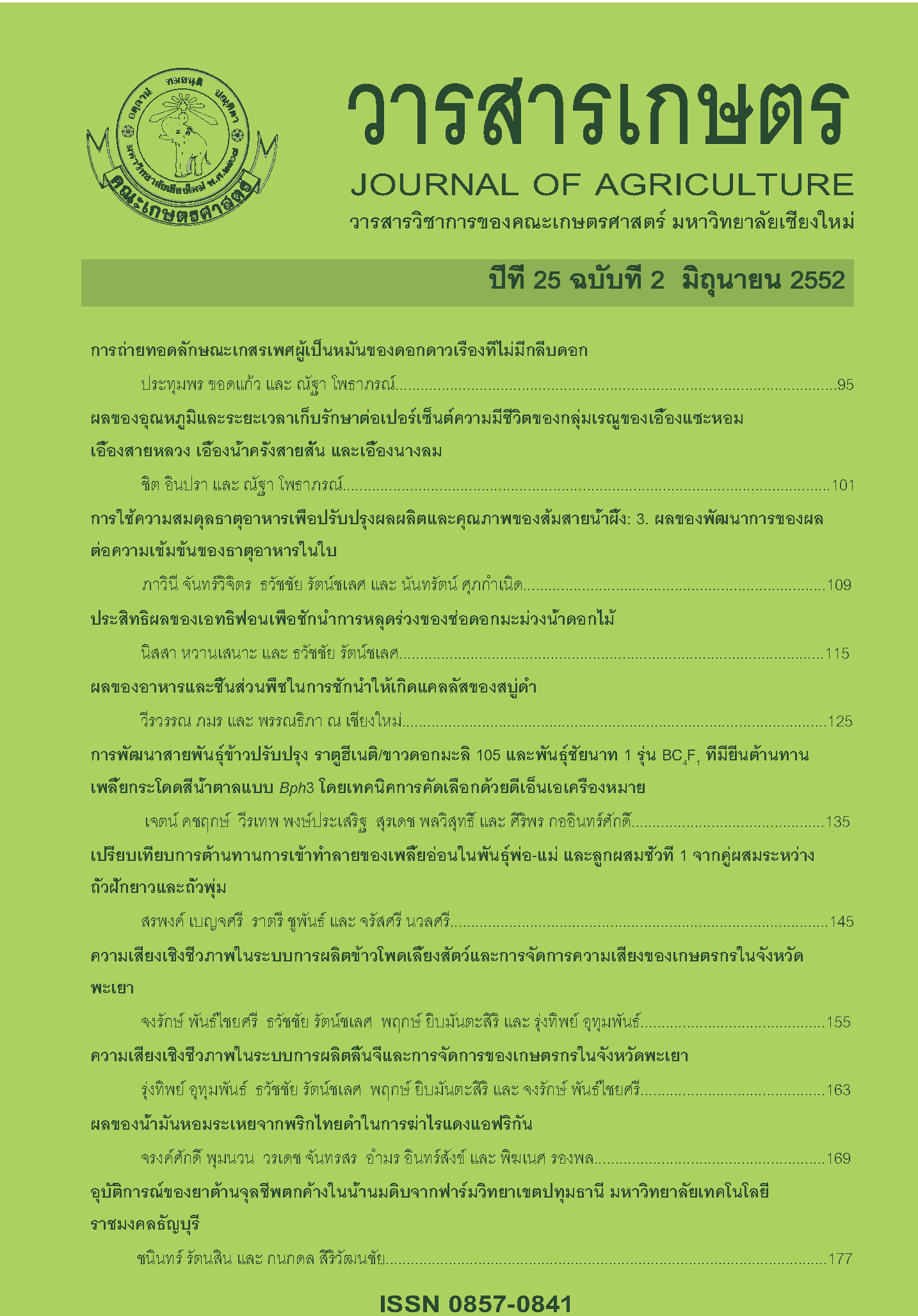การพัฒนาสายพันธุ์ข้าวปรับปรุง ราตูฮีเนติ/ขาวดอกมะลิ 105 และพันธุ์ชัยนาท 1 รุ่น BC4F1 ที่มียีนต้านทานเพลี้ยกระโดด สีน้ำตาลแบบ Bph3 โดยเทคนิคการคัดเลือก ด้วยดีเอ็นเอเครื่องหมาย
Main Article Content
บทคัดย่อ
การพัฒนาข้าวให้ต้านทานต่อเพลี้ยกระโดดสีน้ำตาลนั้น มีการศึกษาวิจัยอย่างกว้างขวาง ตั้งแต่การค้นหายีนต้านทาน การถ่ายโอนยีนเข้าสู่พืชเป้าหมาย และการคัดเลือกสายพันธุ์ลูกผสมที่เกิดขึ้นให้มีคุณลักษณะตรงตามต้องการ รวมถึงการรับรองสายพันธุ์ และกระบวนการอื่น ๆ ที่เกี่ยวข้อง การพัฒนาข้าวพันธุ์ชัยนาท 1 ให้ต้านทานต่อเพลี้ยกระโดดสีน้ำตาลได้ดำเนินการถ่ายโอนยีนต้านทานชนิด Bph3 จากข้าวสายพันธุ์ปรับปรุงราตูฮีเนติ/ขาวดอกมะลิ 105 สู่ข้าวพันธุ์ชัยนาท 1 กำลังอยู่ในขั้นการพัฒนาเช่นกัน ข้าวลูกผสม F1 ของข้าวทั้งสองสายพันธุ์ซึ่งมียีน Bph3 ได้รับการพัฒนาขึ้นสำเร็จ และกำลังเข้าสู่ขั้นตอนการดำเนินการปรับปรุงคุณภาพให้ใกล้เคียงกับพันธุ์ชัยนาท 1 พร้อมกับยังคงคุณลักษณะต้านทานเพลี้ยกระโดดสีน้ำตาลที่เกิดจากยีน Bph3 ไว้ โดยการใช้วิธีการปรับปรุงแบบผสมกลับและเทคนิคการใช้โมเลกุลเครื่องหมายดีเอ็นเอช่วยคัดเลือก โดยสร้างสายพันธุ์ปรับปรุงจำนวน 4 รุ่น คือ BC1F1, BC2F1, BC3F1 และ BC4F1 การคัดเลือกลักษณะทางพันธุกรรมของยีน Bph3 แบบ heterozygous ของลูกผสมสายพันธุ์ปรับปรุงที่เกิดขึ้นในแต่ละรุ่นโดยเทคนิคทางชีวโมเลกุลด้วยโมเลกุลเครื่องหมาย 2 ชนิด คือ RM170 และ RM190 ร่วมกับการคัดเลือกลักษณะทางสัณฐานวิทยาที่เหมือนกับพันธุ์ชัยนาท 1 ด้วยสายตา จากการผสมกลับจำนวน 4 ครั้ง สามารถสร้างลูกผสมสายพันธุ์ปรับปรุงรุ่นที่ 4 (BC4F1) ที่มีลักษณะทางพันธุกรรมแบบ heterozygous ของยีน Bph3 และมีลักษณะทางสัณฐานวิทยาที่เหมือนกับพันธุ์ชัยนาท 1 ทางทฤษฎี ร้อยละ 96.875 จำนวน 20 ต้น
Article Details
เอกสารอ้างอิง
สุรเดช ปาละวิสุทธิ์ วีรเทพ พงษ์ประเสริฐ ศิริพร กออินทร์ศักดิ์ และ ธานี ศรีวงศ์ชัย. 2548. การคัดเลือกดีเอ็นเอเครื่องหมายแบบ SSR ของยีนต้านทานต่อเพลี้ยกระโดดสีน้ำตาลชนิด Bph3 จากข้าวสายพันธุ์ปรับปรุง และพันธุ์ชัยนาท 1. วารสารเกษตร 21(3): 269-276.
สุวัฒน์ รวยอารีย์. 2544. เรียนรู้การจัดการศัตรูข้าวโดยวิธีผสมผสาน. เอกสารวิชาการ กองกีฏและสัตววิทยา กรมวิชาการเกษตร, กรุงเทพฯ.
Allard, R.W. 1960. Principles of Plant Breeding. John Wiley & Sons Inc., New York. 485 pp.
Cho, Y.G., M. Y. Eun, S. R. McCouch and Y. A. Chae. 1994. The semi-dwarf gene, sd-1, of rice (Oryza sativa L.). II. Molecular mapping and marker-assisted selection. Theor. Appl. Genet., 89: 59-59.
Griffiths, A. J. F., J. H. Miller, D. T. Suzuki, R. C. Lewontin and W. M. Gelbart. 1996. An Introduction to Genetic Analysis. 6th ed. W. H. Freeman and Company, New York. 915 pp.
Jairin, J., T. Toojinda, S. Tragoonrung, S. Tayapat and A. Vanavichit. 2005. Multiple genes determining brown planthopper (Nilaparvata lugens Stål) resistance in backcross introgressed lines of Thai Jasmine Rice ‘KDML105’. ScienceAsia 31: 129-135.
Jairin, J., K. Phengrat, S. teangdeerith, A. Vanavichit and T. Toojinda. 2007. Mapping of a broad-spectrum brown planthopper resistance gene, Bph3 , on rice chromosome 6. Mol. Breeding 19: 35-44.
Kawaguchi, M., K. Murata, T. Ishii, S. Takumi, N. Mori and C. Nakamura. 2001. Assignment of a brown planthopper (Nilaparvata lugens Stål) resistance gene bph4 to the rice chromosome 6. Breeding Sci. 51: 13-18.
Khush, G.S. and D.S. Brar. 1991. Genetics of resistance to insects in crop plants. Advances in Agronomy 45: 224-228.
Lafitte, R H., A. H. Price and B. Courtois. 2004. Yield response to water deficit in an upland rice mapping population: associations among traits and genetic markers. Theor. Appl. Genet. 109: 1237-1246.
McCouch, S. R., X. Chen, O. Panaud, S. Temnykh, Y. Xu, Y. G. Cho, N. Huang, T. Tshii and M. Blair. 1997. Microsatellite marker development, mapping and applications in rice genetics and breeding. Plant Mol. Bio. 35: 89-99.
Morgante, M. and A. M. Olivieri. 1993. PCR-amplified microsatellites as markers in plant genetics. Plant J. 3: 175-182.
Paran, I. and R. W. Michelmore, 1993. Development of reliable PCR-based markers linked to downy mildew resistant genes in lettuce. Theor. Appl. Genet. 85: 985-993.
Pflieger, S., V. Lefebvre, C. Caranta, A. Blattes, B. Goffinet and A. Palloix. 1999. Disease resistant gene analogs as candidates for QTLs involved in pepper-pathogen interactions. Genome 42: 1100-1110.
Rongwen, J., M. S. Akkaya, A. A. Bhagwat, U. Lavi and P. B. Cregan. 1995. The use of microsatellite DNA markers for soybean geneotype identification. Theor. Appl. Genet. 90: 43-48.
Vanavichit, A., S. Tragoonrung and T. Toojinda. 2003. Biotechnology and rice varieties improvement. pp. 79-121. In: S. Lorlowhakarn (ed.). Science and Technology with Thai Rice. National Science and Technology Development Agency, Bangkok, Thailand.
Xiao, J. H., S. N. Grandillo, S. N. Ahn, S. R. McCouch, S. D. Tanksley, J. M. Li and L. P. Yuan. 1996. Genes from wild rice improve yield. Nature 384: 223-224.
Yadav, R., B. Courtios, N. Huang and G. McLaren. 1997. Mapping genes controlling root morphology and root distribution in a double-haploid population of rice. Theor. Appl. Genet. 94: 619-632.


